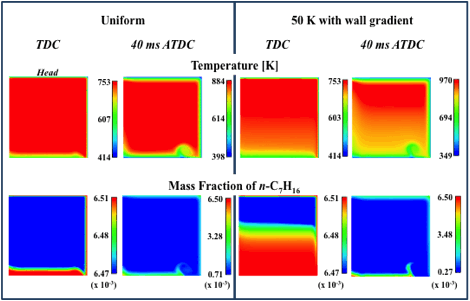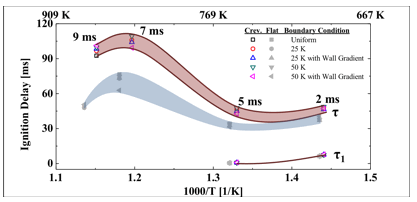Reports: DNI653521-DNI6: High-Fidelity Iso-Octane Ignition Kinetics: New Rigor for an Unresolved Problem
Casey Allen, PhD, Marquette University
Research Progress To-Date
The main objectives of this project can be summarized as (1) experimentally-determining iso-octane ignition delay times and their susceptibility to heat loss effects and (2) using these data to recommend a heat loss modeling approach for rapid compression machine (RCM) experiments.
Experimental measurements were proposed in a variable-speed compression-expansion machine (VSCEM) that compresses a reactive mixture to elevated temperatures and pressures to induce autoignition. The VSCEM is designed to slowly expand the mixture prior to ignition to emulate the influence of heat loss on ignition delay measurements. A schematic of the VSCEM appears in Figure 1, where it is noted that the shape of the cam can be altered to change the expansion rate for an experiment. Photographs of the VSCEM appear in Figure 2.
Figure 1. Top-down VSCEM schematic.
In the first year of the project, significant damage to the VSCEM occurred during testing, resulting in a redesign of some of the components. This design work and the time to fabricate the parts resulted in approximately 3 – 4 months where no experiments could be conducted. In addition to fixing the design, a new safety enclosure was installed to protect the operator from any potential injury in the future. This enclosure can be seen in Figure 2.
Figure 2. Photographs of the VSCEM.
During this experimental downtime, simulation work was pursued in two areas. The first simulation area was the study of how non-uniform boundary temperatures influence rapid compression machine (RCM) experiments. The RCM test device operates like the VSCEM but without the expansion stroke. The second area of simulation was the development of a multi-zone reactor model to represent the thermodynamic conditions that evolve within a RCM or VSCEM experiment. This multi-zone model is a critical piece to understanding how iso-octane ignition measurements are influenced by heat loss effects. The multi-zone model is a tool for rigorous kinetic model validation without the assumption of a zero-dimensional test environment or the need for expensive CFD simulations. The ability of the model to reproduce temperature and species concentrations predicted by CFD appears in Figure 3.
Figure 3. Multi-zone modeling (MZM) results for a simulated RCM experiment. The MZM results are compared with CFD simulations to demonstrate the fidelity of the reduced order model. Results are shown for compression ratios of CR = 9, 10, 11.
The CFD simulations on the influence of non-uniform boundary temperatures were a continuation of simulation work completed in the first year of the project. Last year, we reported CFD simulations of non-reactive mixtures (ignition chemistry neglected) to interrogate how an initially non-uniform temperature field would be propagated into the temperature field at top dead center and into the post-compression period. These studies revealed that an optimized creviced piston can suppress the influence of temperature non-uniformities. However, the non-uniform temperatures did influence the temperatures of the secondary flows in the RCM environment, potentially altering the interpretation of experimental data in the negative temperature coefficient region.
These simulations were continued in the second year of the project, with a focus on including reaction chemistry to directly examine how the non-uniform boundary temperatures would affect the ignition delays. Both "uniform temperature" and "cool piston" cases were simulated, which refer to the boundary conditions in the simulations. A depiction of how the boundary conditions alter the initial temperature field appears in Figure 4. After compression of these test gas mixtures, a hot, compressed gas temperature field is established which ultimately induces ignition. Figure 5 demonstrates that after compression (TDC), two zones can be identified in the RCM charge: (1) a hot uniform zone and (2) a stratified, cooler zone. Interestingly, the global ignition delay responses for the test cases with non-uniformities only varied from the uniform case by 10-15% (Figure 6). However, the simulations demonstrated that under these cases, we could not make a reliable assessment regarding which ignition pathways had actually led to global ignition. In other words, without actually knowing the thermal conditions in the experiment, no firm conclusion could be made about what the experiment had actually measured. These simulation results were reported in January 2015 at the 53rd AIAA Aerospace Sciences Meeting. A peer-reviewed journal publication is currently being written to include results from a final set of simulations.
Figure 4. Initial temperature fields for uniform boundary and "cool piston" cases.
Figure 5. Compressed temperature fields and mass fraction fields from CFD simulations.
Figure 6. Simulated ignition delay times for varying thermal boundary conditions.
Since bringing the VSCEM back online, initial data has been gathered to characterize its performance. Figure 7 demonstrates sample test data from the VSCEM and the experimental repeatability from the device. However, the full set of data has not yet been gathered to quantitatively assess the role of heat losses in the ignition measurements. The PI is requesting a no-cost extension to support one of his graduate students to complete these measurements.
Figure 7. Sample VSCEM test data.
Impact of Research
This project has provided important insight into how RCM experimental measurements are affected by the rigor of setting up the experiment. The forthcoming publication regarding ignition in cooling environments will also make an important contribution to our understanding and interpretation of ignition delay test data. Lastly, the combination of the VSCEM with the multi-zone model will provide a powerful test platform in the future for validating heat release rates during ignition, which is a more rigorous metric than ignition delay time. One graduate student (Mr. John Neuman) has been fully supported for his master's degree with the funding, and a second student (Mr. David Wilson) has received partial support with the grant award. The project has provided these students with the opportunity learn about ignition chemistry, CFD modeling, numerical analysis, and reactor design.


















